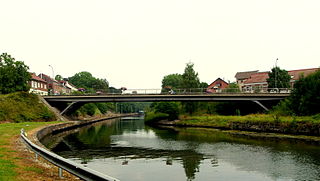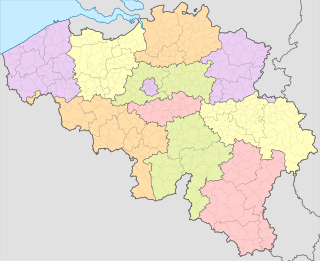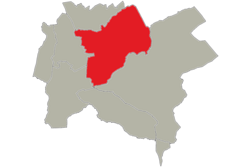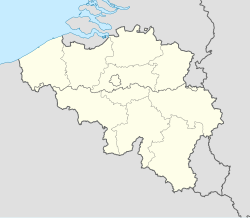
Limburg, also known as Belgian Limburg, is a province in Belgium. It is the easternmost of the five Dutch-speaking provinces that together form the Region of Flanders, which is one of the three main political and cultural sub-divisions of modern-day Belgium. As of January 2024, Limburg had a population of 0.9 million.

Hasselt is a Belgian city and municipality. It is the capital and largest city of the province of Limburg in the Flemish Region.

Diepenbeek is a municipality located in the Belgian province of Limburg near Hasselt. On January 1, 2012, Diepenbeek had a total population of 18,337. Its total area is 41.19 km2 (15.90 sq mi) which gives a population density of 430 inhabitants per square kilometre.

Zonhoven is a municipality located in the middle of the Belgian province of Limburg located north of Hasselt and also borders Houthalen-Helechteren, Genk and Heusden-Zolder. It’s an urbanized municipality, in the edge area of Hasselt. The municipality belongs to the On January 1, 2019, Zonhoven had a total population of 21,237. The total area is 39.34 km2 which gives a population density of 506 inhabitants per km2.

Lanaken is a municipality located in the Belgian province of Limburg. On January 1, 2007, the municipality of Lanaken had a total population of 24,724. Its area is 59.00 km2 which gives a population density of 415 inhabitants per km2.

Hasselt is a city in the municipality of Zwartewaterland about 7 km north of Zwolle, in the Dutch province of Overijssel. After it received city rights in 1252, it became a member of the Hanseatic League around 1350. The city suffered an economic downfall from about 1550 on, as other cities proved to be better situated and equipped for trade and commerce. In 2001 the municipalities of Hasselt, Genemuiden and Zwartsluis were united in the municipality of Zwartewaterland, of which Hasselt became the administrative centre. As of 1 January 2021, Hasselt had a population of 7,385.
Koninklijke Sporting Club Hasselt was a Belgian football club. The matricule No. 37 was erased in 2001 after the merge with K.S.K. Kermt to become K.S.K. Kermt-Hasselt. The club played one season in the first division in 1979–80.

The Arrondissement of Maaseik is one of the three administrative arrondissements in the Province of Limburg, Belgium. It is not a judicial arrondissement. The municipalities of Bocholt, Bree, Kinrooi, Meeuwen-Gruitrode, Dilsen-Stokkem and Maaseik, are part of the Judicial Arrondissement of Tongeren, while the rest of its municipalities are part of the Judicial Arrondissement of Hasselt.

The Arrondissement of Hasselt is one of the three administrative arrondissements in the Province of Limburg, Belgium.

Stevoort is a sub-municipality of the city of Hasselt located in the province of Limburg, Flemish Region, Belgium. It was a separate municipality until 1977. On 1 January 1977, it was merged into Hasselt.

Wimmertingen is a sub-municipality of the city of Hasselt located in the province of Limburg, Flemish Region, Belgium. It was a separate municipality until 1977. On 1 January 1977, it was merged into Hasselt.

Eigenbilzen is a village and former municipality in the Bilzen municipality of the Limburg province in the Flemish Community of Belgium. Eigenbilzen was an independent municipality until 1977 when it merged into Bilzen.

Sint-Lambrechts-Herk is a sub-municipality of the city of Hasselt located in the province of Limburg, Flemish Region, Belgium. It was a separate municipality until 1977. On 1 January 1977, it was merged into Hasselt.

Kermt is a sub-municipality of the city of Hasselt located in the province of Limburg, Flemish Region, Belgium. It was a separate municipality until 1977. In 1971, Spalbeek was merged into Kermt. On 1 January 1977, Kermt was merged into Hasselt.

Spalbeek is a sub-municipality of the city of Hasselt located in the province of Limburg, Flemish Region, Belgium. It was a separate municipality until 1971. In 1971, it was merged into Kermt. On 1 January 1977, Kermt was merged into Hasselt.

Stokrooie is a sub-municipality of the city of Hasselt located in the province of Limburg, Flemish Region, Belgium. It was a separate municipality until 1971. In 1971, it was merged into Kuringen. On 1 January 1977, Kuringen was merged into Hasselt.

Gerard van Groesbeeck (1517–1580) was a prelate who became the 88th Bishop of Liège, as well as Prince-Abbot of Stavelot and a cardinal of the Catholic Church.

The fusion of the Belgian municipalities was a Belgian political process that rationalized and reduced the number of municipalities in Belgium between 1964 and 1983. In 1961, there were 2,663 such municipalities; by 1983, these had been re-arranged and combined into 589 municipalities.

The NIS code is a numeric code for regional areas of Belgium.
Herkenrode is a Belgian abbey beer brewed by the Cornelissen Brewery at Opitter in Bree, Limburg, named after the former Herkenrode Abbey in Hasselt.






















